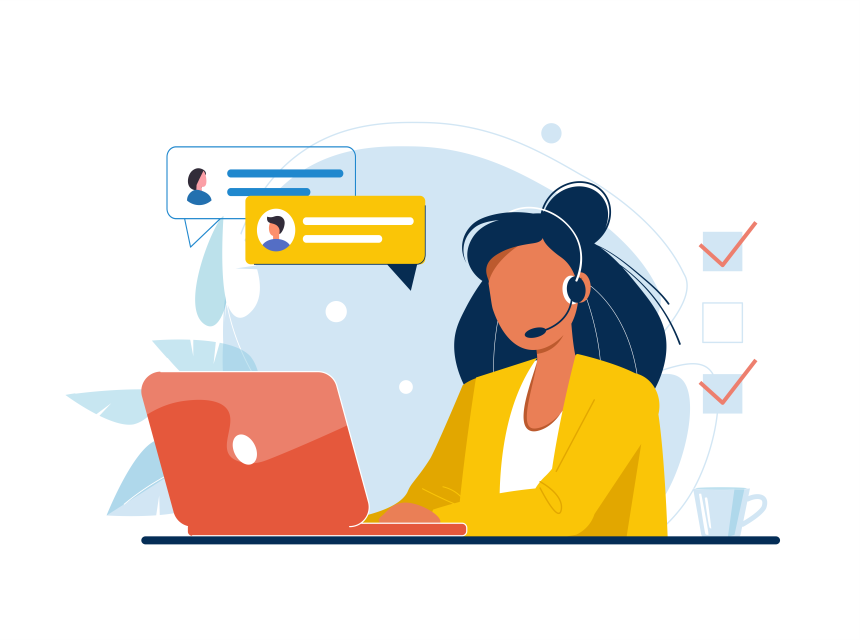How to Calculate Your ROI for your Outbound Call Center Software
by Nicole Robinson | Published On November 7, 2024

Contact centers aren’t just an environment for managing inbound calls. In many industries, companies rely on outbound call center software to improve customer engagement and revenue.
Whether you’re using an automatic dialling system to generate leads, following up with customers to close deals, or delivering proactive support, the right outbound software is crucial.
However, despite widespread adoption of outbound call center solutions, companies often struggle to measure their impact on the bottom line and growth. Not all outbound systems are created equal, and calculating the return on investment (ROI) of your outbound call center software is crucial to ensuring you’re investing in the right technology.
Here, we’ll show you how to effectively calculate the return on investment from your outbound call center solution and give you some tips on how to optimize your ROI.
What is an Outbound Call Center?
An outbound call center is a business operation that allows agents and representatives to make outgoing calls to consumers, prospects, and leads. Unlike inbound call centers, where agents respond to incoming queries, outbound call centers are all about initiating contact.
In the business landscape, companies rely on outbound call center software for lead generation and sales outreach, appointment setting, collecting customer feedback, and delivering proactive support.
A comprehensive solution for outbound campaign management will usually include a range of features, including auto-dialing systems to enable rapid outreach at scale, call monitoring and recording tools for compliance, and analytical software for insights and quality assurance.
Outbound call center software is a fundamental resource for many organizations. It acts as a powerful tool for direct customer engagement, whether you’re delivering support, selling products, or gathering feedback. Most solutions also integrate seamlessly with inbound contact center tools, creating a comprehensive environment for business to consumer communications.
What is ROI and Why Is It Important?
ROI stands for “Return on Investment,” a financial metric that measures the profitability or impact a solution has on your company’s bottom line and growth. Essentially, this metric shows you whether the value of a solution (like your outbound call center software) is worth more than the cost of implementing and managing it.
In the context of an outbound call center, ROI determines whether the investment in call center software, infrastructure, and personnel is generating sufficient returns, such as increased sales, customer retention, or improved operational efficiency.
Since running an outbound call center requires a significant investment in staff, technology, and ongoing training, calculating ROI is crucial to ensure your strategy is cost-effective.
With an insight into ROI, you can:
- Identify cost efficiency: Calculating ROI helps you to determine whether your call center technology is cost-efficient. If the cost of your software is high, and the return on investment is low, this could indicate you’re using the wrong technology.
- Validate investments: Calculating the ROI of an outbound call center solution ensures you can validate the benefits of that technology for key stakeholders. It provides direct insights into how your investment is driving increased conversions, or higher customer lifetime value.
- Measure performance: Regularly assessing outbound call center software ROI ensures you can rapidly spot when your software is becoming outdated and inefficient. It also gives you a valuable way to compare strategies for outbound calling, based on their performance.
- Improve resource allocation: Understanding your company’s return on investment allows for better decision-making on how to allocate resources. You can decide whether to invest more in software, personnel, or training to boost productivity and efficiency.
How to calculate your ROI
Figuring out how to calculate the ROI of your outbound call center software can be more complex than it seems. The impact your technology has on your revenue or profitability isn’t always immediately evident. Getting true insight means not only assessing the total cost of ownership (TCO) for your software but understanding how performance metrics affect your bottom line.
You’ll need to consider the exact impact that things like improved employee productivity and increased customer satisfaction have on your organization’s financial performance.
Step 1: Calculate Total Cost of Ownership (TCO)
To calculate the return on investment for your outbound call center software, you first need to understand the full cost of your investment. This means assessing the Total Cost of Ownership (TCO) for your technology. The cost of your outbound call center software isn’t just based on how much you spend on a monthly subscription.
You’ll need to consider all of the following:
- Licensing fees: The upfront cost of purchasing the software. This will include the monthly or annual fees you pay for automatic dialing solutions, alert systems, and workflow designers.
- Implementation costs: The expenses associated with setting up your software, such as configuration, system integration, and customization fees.
- Training costs: How much it costs to initially train your employees to use the system, and provide consistent training based on feature updates.
- Maintenance and support costs: The costs connected to keeping your software running smoothly. This could include paying for services and IT support to assist with bug fixes, applying updates, and implementing new features.
- Additional fees: Additional fees could include hardware costs, for those who require specific endpoints and tools, and hidden costs, such as extra fees incurred from adding a new feature to a system or enabling access for additional users.
Calculating the TCO will give you a holistic view of how much you’re actually spending to run your outbound call center software, so you can compare the price to the profit.
Step 2: Measure Performance Improvements
The right outbound call center software can deliver ROI in various ways. It can improve conversion rates and enhance customer lifetime value by boosting satisfaction. It can also deliver a return on investment by saving you money on operational costs, such as hiring extra employees to manage outreach campaigns at scale.
The most important metrics you’ll need to track, using the reporting tools connected to your contact center software include:
- Call volume: The more calls your team members can make in a shorter amount of time, the more leads you can generate and convert. Tools like auto-dialers and predictive dialers reduce the time spent on calls, and idling between calls. They can boost team efficiency, and help agents manage more calls per hour.
- Conversion rates: Conversion rate is the percentage of calls that result in a successful outcome, such as a sale, appointment, or lead generation. Outbound call center software can improve conversion rates by providing agents with CRM integration, customer history, and real-time call scripts, allowing for more personalized and effective conversations.
- Call handling times: Effective outbound call center software reduces average handling times by streamlining and automating processes and providing agents with rapid access to data. Lower call handling times mean agents can handle more conversations in a shorter period, reducing operational costs.
- Customer satisfaction: The right outbound call center technology can help you personalize interactions with customers, and deliver proactive, predictive services. This leads to higher customer satisfaction rates, which can increase customer retention, improve average order value, and boost customer lifetime value.
- Employee performance metrics: Not only do outbound call center solutions boost employee efficiency and productivity with automation and intuitive tools, but they can enhance employee satisfaction too. This reduces the costs associated with recruiting and onboarding new employees, by minimizing talent turnover.
Step 3: Assign a Monetary Value to Gains
This step is probably the most complex part of calculating the ROI of outbound call center software. It’s not always easy to get a clear view of how certain performance improvements, like decreased handling time, or boosted customer satisfaction translate into financial gains.
The key to success is usually benchmarking performance metrics before implementing a new outbound strategy, so you have a clear point of comparison.
A few points to look at include:
Revenue from Increased Conversions
One of the easiest metrics to monetize is the increase in conversions. If your outbound call center software allows you to reach 20% more customers on average per day, and therefore increases the number of customers you convert by 5%, you can calculate the revenue this generates.
For instance, if your team makes 1000 successful calls per day, and each successful conversion is worth $500 in revenue, an increase of just 20 successful conversions per day is worth an extra $10,000 in revenue.
Cost Savings from Increased Efficiency
Money you save is just as good as money you earn for your company’s bottom line. Software that improves agent productivity and reduces call handling times results in cost savings. For example, if your outbound call center software reduces average call times by 20%, and improves performance by 20%, then you could potentially reduce your staff by 20% and achieve the same output.
To calculate the return on investment this delivers, you simply need to look at the average cost per hour to hire your employees. For example, if each agent costs $25 per hour and the software saves 2 hours of work per day across 10 agents, that’s $500 in daily savings, or roughly $130,000 annually.
The Value of Improved Customer Satisfaction
If you’re using your outbound call center solution to send appointment reminders to customers, or provide proactive service, this can significantly improve customer satisfaction. The ROI of customer satisfaction can be difficult to calculate. However, one thing you can look at is the value of retention.
If your software boosts customer satisfaction to the point that you’re seeing a 10% reduction in churn, you can calculate the lifetime value of your retained customers. Say your average customer is worth $1,000 throughout their lifetime, reducing churn by 100 customers would save $100,000 in lost revenue.
Step 4: Calculate ROI
Now that you’ve calculated the TCO of your outbound call center software, measured performance improvements, and assigned monetary values to your gain, you can calculate ROI. The formula for calculating ROI is:
ROI = [(Net gains from investment – cost of investment) / cost of investment] x 100.
Here’s an example of what an ROI calculation might look like for your outbound call center software. Imagine the TCO for your software is $40,000 per year. You’ve identified that your software leads to:
- $50,000 in additional revenue from increased conversions
- $30,000 in cost savings from improved efficiency
- $20,000 in the value of retained customers
That means you’ve earned $100,000 in “net gains”. Using the ROI formula:
ROI = [(100,000-40,000)/ 40,000] x 100 = 150%.
This means your ROI is 150%, indicating your software is delivering 1.5 times the value of your initial investment. In other words, your software is paying off.
Step 5: Monitor and Optimize
Calculating the ROI of your outbound call center software isn’t an ongoing activity. You need to check your metrics regularly, to ensure your technology continues to deliver the same value.
Business environments, customer needs, and market dynamics constantly change, making it critical to stay vigilant about how your software is performing and whether it is meeting expectations.
Regularly monitoring your ROI helps you:
- Keep track of changing performance metrics: Metrics like call volume, conversion rates, and customer satisfaction can fluctuate due to new campaigns, market conditions, or changes in agent performance. By regularly monitoring these KPIs, you can spot trends early and make data-driven decisions to maintain or improve ROI.
- Optimize software: Software utilization usually improves with time as agents become more familiar with the tool, but it’s also important to ensure that the features are fully utilized. Assessing software performance regularly can reveal areas where additional training, feature usage, or updates can further enhance efficiency and outcomes.
- Make call strategy improvements: You can compare the ROI of different outbound strategies to see which delivers the best results. For instance, you might compare the results of predictive dialing to progressive dialing strategies.
Improving Outbound Call Center ROI
Now that you know how to calculate ROI for your outbound call center software, the next step is figuring out how to improve your results. Here are our top tips for maximizing your ROI.
Use Automation
Automation is a powerful tool for boosting software ROI. Solutions like iceCampaign from ComputerTalk make it easy to access a range of automated dialing options. The tool uses preview, progressive, predictive, and IVR dialing options, to save agents’ time.
With automation, your teams can spend less time dialing, and more time interacting with customers. This reduces operational costs and improves productivity. You can even use automation to quickly load prospects into a system for sales teams or filter out incomplete numbers from lists.
Train your Employees
Automation can reduce a lot of the work your outbound employees need to do. However, they still need to be efficient in their roles to ensure they can move through calls quickly and effectively. That’s where a strong training strategy comes in.
Train your team members on how to use outbound software effectively. Show them how to leverage integrations with CRM systems to personalize customer interactions. Give them tips on how to manage conversations faster with sales scripts and best practices. Better training leads to improved call handling rates, higher conversions, and higher customer satisfaction.
Take a Data-Driven Approach
Sometimes, the best way to boost the ROI of your outbound calling strategy is to rethink who you’re reaching out to. By analyzing customer data, businesses can identify more “qualified” prospects for sales teams. This ensures employees spend the majority of their time on the right opportunities.
Analyzing your data can also help you to segment customers by buyer behavior or demographics. This can help you identify when to contact specific customers, what messages to use in sales scripts, and even which offers to suggest. That can significantly increase your conversion rates and improve your relationships with your audience.
Experiment with AI
Similar to automation, AI is a fantastic tool for an outbound contact center. AI tools like intelligent IVR systems can handle outbound interactions with customers on behalf of agents. This reduces the need to invest in additional employees for large-scale campaigns. It also means your team members can focus on more valuable tasks.
Plus, AI can analyze the data from your outbound interactions and suggest ways to improve ROI. There are even AI-powered coaches that can integrate with your contact center technologies. These can offer real-time guidance to employees that helps them boost conversion rates.
Be More Proactive
Remember, an outbound call center doesn’t just have to be for sales and marketing campaigns. You can also use it to proactively notify customers of issues or help them troubleshoot problems. This way, instead of waiting for customer complaints or missed opportunities, you can engage your customers in advance.
You can even use proactive strategies to reach out to customers with rewards and offers that encourage them to renew subscriptions and services, increasing lifetime value. The right proactive approach can help strengthen relationships and increase sales opportunities.
Optimizing The ROI of Your Outbound Call Center Software
Calculating the ROI of an outbound call center can seem complicated, but it’s an essential part of making sure you’re getting the most value out of your technology. With the right insights into ROI, you’ll be able to ensure you’re investing the right amount of time and resources into your outbound campaigns.
ComputerTalk’s iceCampaign offers the ultimate solution for outbound campaign optimization. With multiple dialing modes, seamless CRM integration, and intuitive reporting tools, iceCampaign can help you consistently optimize your outbound strategies.
Contact us today to request a demo of our software, or learn more about iceCampaign here.
More from our blog
 Discover six ways healthcare providers can use communication technologies to improve operational efficiency and patient care.
Discover six ways healthcare providers can use communication technologies to improve operational efficiency and patient care.
 Discover 10 clear ways to solve customer issues on the first call. Cut costs, save time, and keep people coming back to your business.
Discover 10 clear ways to solve customer issues on the first call. Cut costs, save time, and keep people coming back to your business.
 As the developer of the Teams native ice Contact Center, ComputerTalk is currently one of the first companies to go through Microsoft’s Connected Contact Center for Microsoft Teams Certification Program. Among other benefits, this certification will mean that ice Contact...
As the developer of the Teams native ice Contact Center, ComputerTalk is currently one of the first companies to go through Microsoft’s Connected Contact Center for Microsoft Teams Certification Program. Among other benefits, this certification will mean that ice Contact...

